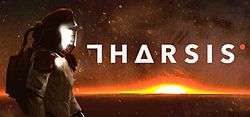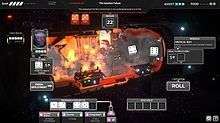Tharsis (video game)
| Tharsis | |
|---|---|
 Steam banner of the game | |
| Developer(s) | Choice Provisions |
| Publisher(s) | Choice Provisions |
| Designer(s) | Zach Gage |
| Engine | Unity |
| Platform(s) | Windows, Mac OS X, PlayStation 4 |
| Release | January 12, 2016 |
| Genre(s) | Strategy |
| Mode(s) | Single-player |
Tharsis is a strategy video game developed and published by Choice Provisions. It was released in January 2016 for Windows and Mac OS X through the download service Steam, as well as for PlayStation 4.
The game received polarized critical reviews, with some praising the deep strategic gameplay while others bemoaned the apparent overemphasis on random chance.
Gameplay
Tharsis allows players to control four astronauts with unique jobs and abilities inside a heavily damaged spacecraft on the first manned mission to Mars.[1] The game lasts for 10 in-game weeks, during which time the player must attempt to reach Mars without any of the crew perishing.[1] Every turn, new events will appear that are in need of repair, and if left alone have the possibility to destroy the ship or kill the crew.[1] The player can click each astronaut to deploy them to a certain capsule for that turn and repair them using the astronaut's dice.[1] If a capsule is not repaired after all crew members move, the negative effect will trigger.[1]
Each dice roll can be subtracted from the capsule's repair number until it reaches zero, and the capsule is repaired.[1] The astronauts can carry a max of five dice, but lose one each time they roll unless otherwise replenished. Each astronaut also has a max of six health points. At the beginning of the game, the astronauts start with random amounts of dice and HP, though the total amount distributed among the crew is always the same.

Disasters can come with three types of hazards, Stasis, Injury and Void. Stasis prevents a die from being re-rolled if it lands on a low number. Injury decreases the character's HP, or kills them if their HP drops too low, and Void causes dice of a certain number to disappear instantly. These hazards can be avoided by gaining Assists; there are a max of three Assists at a time, and one is consumed to prevent a hazard.[2] Every week, the player gains a single bonus Assist.
Besides using the dice to repair, each module has a special ability that can only be activated by certain dice.[1] The Command Module negates movement damage, the Greenhouse allows harvesting of food that can replenish dice, Life Support directly replenishes a single astronaut's dice supply, the Medical Bay can restore a character's health to full, Operations lowers a character's stress, the Lab replenishes Assists, and Maintenance repairs the ship.
Extra dice can also be put into Research, which contains varying projects that can be used to assist the crew.[3] This functions to balance out the random chance of the dice by allowing the choice of trading off a potential repair for an even larger beneficial effect.
At the end of each week, crew can work on side projects that the player can choose from.[1] Usually, these side projects have a positive and negative effect. The negative effects are increased depending on the crew's sanity, and if crew are allowed to go insane, they will work on a solo side project that will have a more drastic effect than usual, and may even harm the other crew.[1] The crew can also eat food, if any, during this time, which replenishes three dice.[1]
The game also features optional cannibalism if the crew runs out of food.[1] The player can choose to feed the body of a crew member who died in the beginning of the game to various surviving crew.[1] This only replenishes dice by two, while also drastically raising their stress and decreasing their maximum health by one. It also causes their dice to be bloody and decreases the total score the player can receive, in addition to causing the final results screen to be bloody. Players can even kill a living crew member to obtain even more food and increase its effects, though this is almost always a poor strategic decision.
Plot
The game is set in the near future, where Earth has received a mysterious signal from Tharsis on Mars. Believing it to be signs of extraterrestrial life, the ship Iktomi is built and launched with six crewmembers to travel to Mars and investigate the anomaly. Depending on the characters used, the voice of the commander will be either male or female.
However, halfway through their mission, the ship is suddenly hit by a micrometeorite storm that kills two crew members, Mapiya Musgrave and J. Cross, and destroys the Pantry where the food is stored. With limited food supplies and crew, disasters start running rampant throughout the ship, and the astronauts are forced to constantly fight to survive. Despite still being able to contact Mission Control, they are unable to turn back home.
During the journey, the crew deciphers data sent from Tharsis and realizes that it shows what seems to be an exact copy of the crew of the Iktomi who are in dire straits. Unsure of what to make of this data, they manage to survive until they reach Mars and launch the capsule, while the Iktomi remains in orbit and is destroyed.
The crew tracks down the signal and comes across an alien artifact. Suddenly, the artifact flashes with a bright light. If one or more of the Iktomi's crew is dead, the artifact's energy release seemingly kills everyone. One of the crew manages to survive long enough to send a distress call, which the artifact sends back in time, creating a causal loop. However, if all of the crew survive, then one of the crew members manages to pick up a rock and throw it at the artifact, destroying it in a massive explosion, with their ultimate fate unknown.
Development
According to an interview with Mike Roush, co-founder of Choice Provisions, the original inspiration for Tharsis was the story of the whaling ship Essex, which was sunk by a whale, forcing the crew to resort to desperate attempts to stay alive, including cannibalism.[4] The game was also inspired by the Apollo 13 mission and the fact that they were forced to use unusual household items to maintain the air scrubber.[5]
The game was also created out of Choice Provisions's desire not to be "typecast" as a studio that only developed the Bit.Trip series or worked in an 8-bit retro style.[4]
Tharsis's art style was based on 70's sci-fi designs such as those used in Space: 1999 and UFO, but which was updated to be realistic in a modern-day context.[5] The pastel color scheme was derived from that of a children's xylophone.[5]
The soundtrack of Tharsis consists of tracks from the album Half Age EP by Weval.[6]
The dice mechanic was used due to a perceived resurgence in the popularity of board games, as well as due to the uniqueness of the concept in video games.[4] A challenge that was noted was the high learning curve of the game, which caused people to abandon it instead of watching the tutorial or delving deeper into the strategic mechanics.[4]
The game was balanced to provide a degree of challenge such that players could not beat the game on their first try, but required repeated attempts to be able to get further and further.[4] The game's development took approximately two years to complete.[4]
Reception
Since its release on Steam, Tharsis has received mixed reception, holding an aggregate score of 61/100 on Metacritic.[7] Matt Peckham of Time scored the game 5 out of 5, calling it "ingenious" and "brutally exacting".[3] Reviewer Andrei Dumitrescu of Softpedia gave it a positive review, citing "interesting mechanics" and "a lot of replayability", despite the high difficulty, and that the game showed how humans persevere in the face of hopeless odds.[8] Tyler Wilde of PC Gamer rated the game poorly, calling it highly "dependent on chance" and suggesting that the difficulty varies widely depending on how good your dice rolls are for that particular playthrough.[2]
Brian Dumlao of Worthplaying scored the game moderately, praising the "lovingly rendered" graphics of the ship despite the "generic" characters, and saying the music was "done very well", though mentioning that the game was "not for everyone", and that people who weren't comfortable with losing far more often than they would win would be unhappy with the game.[1]
According to designer Zach Gage, the game was one of the most critically divisive he ever worked on.[9] The game received an overall negative response from publications that were video game focused, while it received a more positive response from streamers, board game players, and developers.[9] He believes this is due to the fact that games of chance are usually used as a lazy shortcut to make things harder, or to take the player's money in mobile games, which caused the gameplay of Tharsis to be overlooked.[9]
References
- 1 2 3 4 5 6 7 8 9 10 11 12 13 "PC Review – 'Tharsis'". Retrieved 2016-08-25.
- 1 2 "Tharsis review". Retrieved 2016-08-25.
- 1 2 Peckham, Matt. "Review: 'Tharsis' Is an Ingenious Game That Will Break You". TIME.com. Retrieved 2016-08-25.
- 1 2 3 4 5 6 "Tharsis PC Interview | GameWatcher". www.gamewatcher.com. Retrieved 2016-08-25.
- 1 2 3 Choice Provisions (2015-11-17), The Origins of Tharsis, retrieved 2016-08-25
- ↑ "Choice Provisions on Twitter". Retrieved 2016-08-25.
- ↑ "Tharsis". Metacritic. Retrieved 2016-08-25.
- ↑ Dumitrescu, Andrei. "Tharsis Review (PC)". Retrieved 2016-08-25.
- 1 2 3 Kuchera, Ben (2016-01-27). "Death is random, but so is survival: Learning to love random chance in Tharsis". Polygon. Retrieved 2016-08-25.